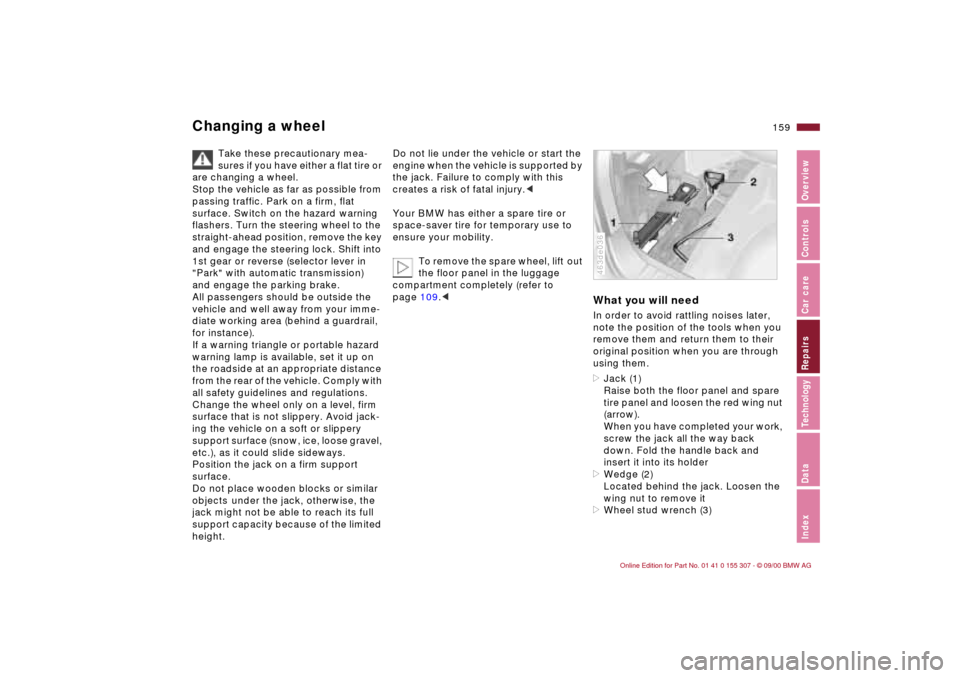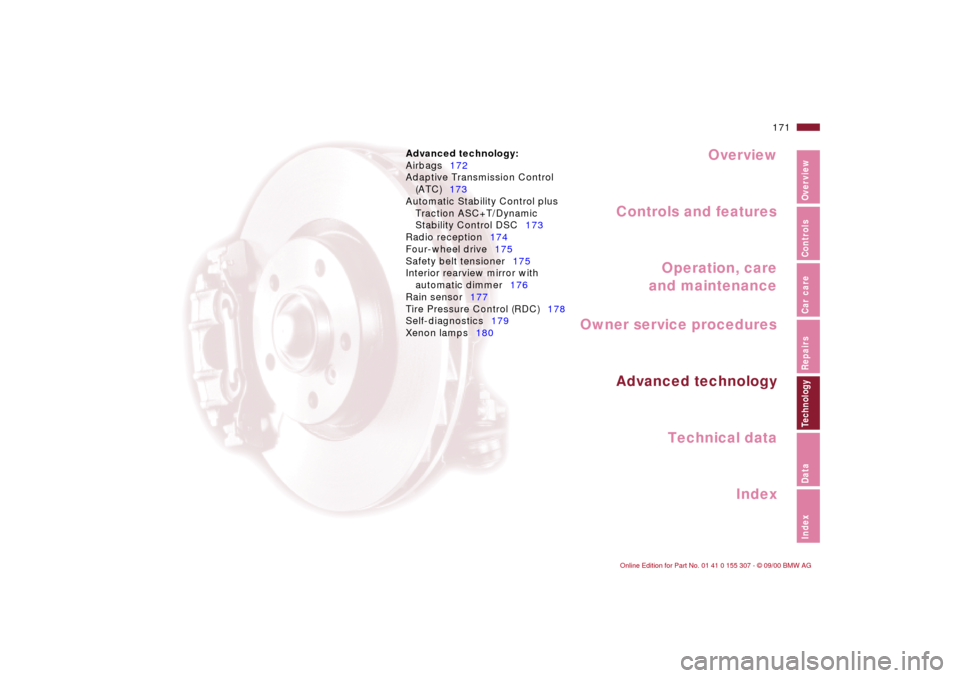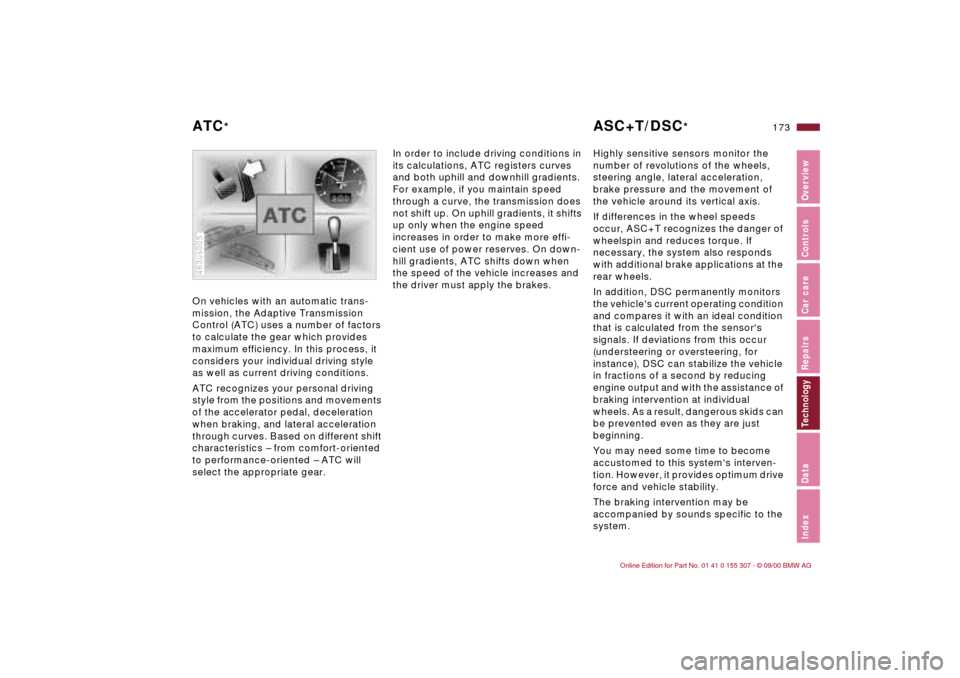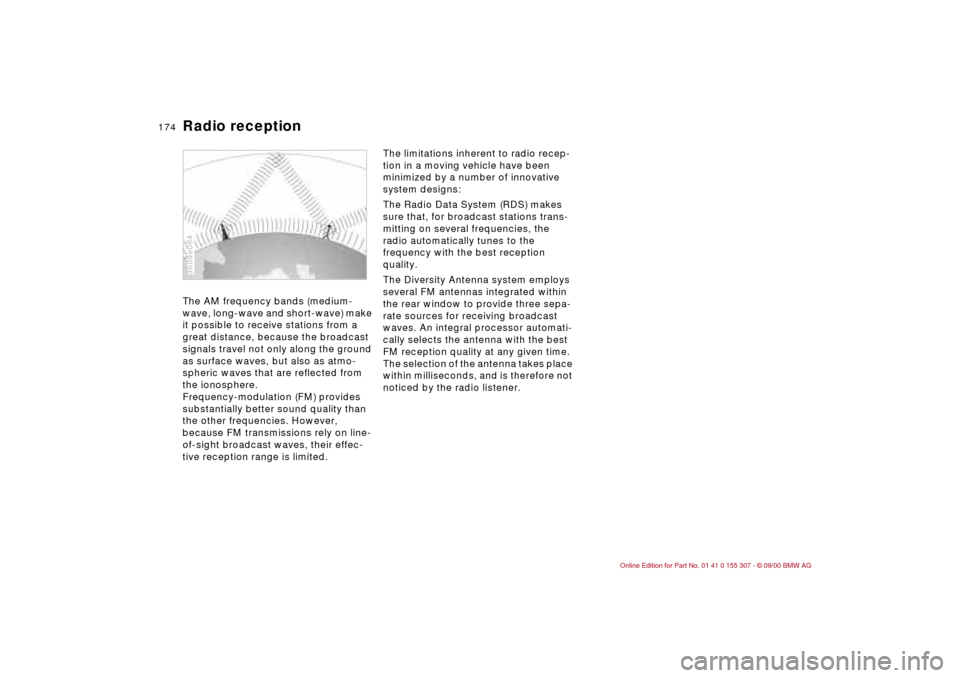2001 BMW 330i TOURING automatic transmission
[x] Cancel search: automatic transmissionPage 159 of 203

159n
IndexDataTechnologyRepairsCar careControlsOverview
Changing a wheel
Take these precautionary mea-
sures if you have either a flat tire or
are changing a wheel.
Stop the vehicle as far as possible from
passing traffic. Park on a firm, flat
surface. Switch on the hazard warning
flashers. Turn the steering wheel to the
straight-ahead position, remove the key
and engage the steering lock. Shift into
1st gear or reverse (selector lever in
"Park" with automatic transmission)
and engage the parking brake.
All passengers should be outside the
vehicle and well away from your imme-
diate working area (behind a guardrail,
for instance).
If a warning triangle or portable hazard
warning lamp is available, set it up on
the roadside at an appropriate distance
from the rear of the vehicle. Comply with
all safety guidelines and regulations.
Change the wheel only on a level, firm
surface that is not slippery. Avoid jack-
ing the vehicle on a soft or slippery
support surface (snow, ice, loose gravel,
etc.), as it could slide sideways.
Position the jack on a firm support
surface.
Do not place wooden blocks or similar
objects under the jack, otherwise, the
jack might not be able to reach its full
support capacity because of the limited
height.
Do not lie under the vehicle or start the
engine when the vehicle is supported by
the jack. Failure to comply with this
creates a risk of fatal injury.<
Your BMW has either a spare tire or
space-saver tire for temporary use to
ensure your mobility.
To remove the spare wheel, lift out
the floor panel in the luggage
compartment completely (refer to
page 109.<
What you will needIn order to avoid rattling noises later,
note the position of the tools when you
remove them and return them to their
original position when you are through
using them.
>Jack (1)
Raise both the floor panel and spare
tire panel and loosen the red wing nut
(arrow).
When you have completed your work,
screw the jack all the way back
down. Fold the handle back and
insert it into its holder
>Wedge (2)
Located behind the jack. Loosen the
wing nut to remove it
>Wheel stud wrench (3) 463de036
Page 171 of 203

Overview
Controls and features
Operation, care
and maintenance
Owner service procedures
Technical data
Index Advanced technology
171n
IndexDataTechnologyRepairsCar careControlsOverview
Advanced technology:
Airbags172
Adaptive Transmission Control
(ATC)173
Automatic Stability Control plus
Traction ASC+T/Dynamic
Stability Control DSC173
Radio reception174
Four-wheel drive175
Safety belt tensioner175
Interior rearview mirror with
automatic dimmer176
Rain sensor177
Tire Pressure Control (RDC)178
Self-diagnostics179
Xenon lamps180
Technol-
Page 173 of 203

173n
IndexDataTechnologyRepairsCar careControlsOverview
On vehicles with an automatic trans-
mission, the Adaptive Transmission
Control (ATC) uses a number of factors
to calculate the gear which provides
maximum efficiency. In this process, it
considers your individual driving style
as well as current driving conditions.
ATC recognizes your personal driving
style from the positions and movements
of the accelerator pedal, deceleration
when braking, and lateral acceleration
through curves. Based on different shift
characteristics Ð from comfort-oriented
to performance-oriented Ð ATC will
select the appropriate gear.463us005
In order to include driving conditions in
its calculations, ATC registers curves
and both uphill and downhill gradients.
For example, if you maintain speed
through a curve, the transmission does
not shift up. On uphill gradients, it shifts
up only when the engine speed
increases in order to make more effi-
cient use of power reserves. On down-
hill gradients, ATC shifts down when
the speed of the vehicle increases and
the driver must apply the brakes.Highly sensitive sensors monitor the
number of revolutions of the wheels,
steering angle, lateral acceleration,
brake pressure and the movement of
the vehicle around its vertical axis.
If differences in the wheel speeds
occur, ASC+T recognizes the danger of
wheelspin and reduces torque. If
necessary, the system also responds
with additional brake applications at the
rear wheels.
In addition, DSC permanently monitors
the vehicle's current operating condition
and compares it with an ideal condition
that is calculated from the sensor's
signals. If deviations from this occur
(understeering or oversteering, for
instance), DSC can stabilize the vehicle
in fractions of a second by reducing
engine output and with the assistance of
braking intervention at individual
wheels. As a result, dangerous skids can
be prevented even as they are just
beginning.
You may need some time to become
accustomed to this system's interven-
tion. However, it provides optimum drive
force and vehicle stability.
The braking intervention may be
accompanied by sounds specific to the
system.
ATC
*
ASC+T/DSC
*
Page 174 of 203

174n
Radio receptionThe AM frequency bands (medium-
wave, long-wave and short-wave) make
it possible to receive stations from a
great distance, because the broadcast
signals travel not only along the ground
as surface waves, but also as atmo-
spheric waves that are reflected from
the ionosphere.
Frequency-modulation (FM) provides
substantially better sound quality than
the other frequencies. However,
because FM transmissions rely on line-
of-sight broadcast waves, their effec-
tive reception range is limited. 360de084
The limitations inherent to radio recep-
tion in a moving vehicle have been
minimized by a number of innovative
system designs:
The Radio Data System (RDS) makes
sure that, for broadcast stations trans-
mitting on several frequencies, the
radio automatically tunes to the
frequency with the best reception
quality.
The Diversity Antenna system employs
several FM antennas integrated within
the rear window to provide three sepa-
rate sources for receiving broadcast
waves. An integral processor automati-
cally selects the antenna with the best
FM reception quality at any given time.
The selection of the antenna takes place
within milliseconds, and is therefore not
noticed by the radio listener.
Page 175 of 203

175n
IndexDataTechnologyRepairsCar careControlsOverview
Four-wheel drive Safety belt tensionerThe transmission of power to the four
drive wheels is provided permanently
through a transfer box. The distribution
of torque between the front and rear
axles is 38% to 62%.
Traditional differential locks at the front
and rear axles and in the transfer box
are not required. Their function is
assumed by automatic braking inter-
vention at all four wheels. These trac-
tion interventions are governed by
Automatic Differential Brake (ADB-X), a
sub-function of DSC.
If a wheel tends to slip, it is braked
automatically by ADB-X until it once
again gains traction, and drive force
can be transmitted to that wheel. In
addition, the drive force is distributed to
the remaining wheels during this 530us133
system intervention. Engine output is
also reduced if necessary.
When the DSC is deactivated, the
ADB-X traction intervention is set for
the maximum drive force. However, the
engine intervention and the stability
controls are no longer available. For
this reason, DSC should only be deacti-
vated in the exceptional circumstances
described on page 81.
The BMW 325xi is not an off-road
vehicle. Instead, permanent four-wheel
drive provides a high degree of vehicle
stability and tractive ability under all
road conditions, and will aid you in crit-
ical driving situations, e. g. driving in
extreme winter conditions or on loose
road surfaces.The safety belt tensioner responds to
severe frontal collisions by tightening
the belts to ensure that occupants
remain firmly positioned in their seats.
A gas-pressure system retracts the
buckle assembly to tension the
shoulder and lap belts within fractions
of a second. This reduces the tendency
to slide under the lap belt.
390de330
Page 186 of 203

186n
Weights
BMW 325i BMW 325xi
Curb weight (with one person, ready for operation, full tank of fuel, options not included)
with manual transmission
with automatic transmissionlb. (kg)
lb. (kg)3,384 (1,535)
3,428 (1,555)3,627 (1,645)
3,693 (1,675)
Approved gross vehicle weight
with manual transmission
with automatic transmissionlb. (kg)
lb. (kg)4,531 (2,055)
4,576 (2,075)4,729 (2,145)
4,795 (2,175)
Approved front axle weight lb. (kg) 2,006 (910) 2,183 (990)
Approved rear axle weight lb. (kg) 2,579 (1,170) 2,668 (1,210)
Approved roof load capacity lb. (kg) 165 (75) 165 (75)
Luggage compartment capacity cu. ft. (liters) 15.4 - 47.5 (435 - 1,345) 15.4 - 47.5 (435 - 1,345)
Approved axle loads and approved gross vehicle weight may not be exceeded.
Page 187 of 203

187n
IndexDataTechnologyRepairsCar careControlsOverview
Capacities
Notes
Fuel tank
reserve gal. (liters)
gal. (liters)approx. 16.6 (approx. 63)
approx. 2.1 (approx. 8)Fuel specification: page 28
Windshield washer system/
Headlamp washer system (front)
Rear window washer system (rear)quarts (liters)
quarts (liters)approx. 5.6 (approx. 5.3)
approx. 2.4 (approx. 2.3)For details: page 134
Cooling system including heater circuit quarts (liters) approx. 8.9 (approx. 8.4) For details: page 137
Engine oil filter change quarts (liters) 325i approx. 6.9
(approx. 6.5)
325xi: approx. 7.9
(approx. 7.5)BMW High Performance
synthetic oil
Specifications: page 136
Manual and automatic transmission and
differentialÐ Lifetime fluid, no fluid change
required
Page 192 of 203

Everything from A to ZA
ABS (Antilock Brake
System)22,116
Accessories6
Activated-charcoal
filter100,165
Adaptive Transmission
Control (ATC)65,173
Adding engine oil135
Adding washer
fluid134,187
Adjust
backrest47
steering wheel50
temperature92
thigh support area48
Air conditioner90
Air distribution92,98
Air nozzles90
Air outlets96
ventilation90,96
Air pressure124
Air supply92,99
Airbags21,58,147,172
Alarm system41
Antenna123
Antenna Diversity174
Antifreeze137
radiator121
Antilock Brake System
(ABS)22,116
Anti-theft alarm system41
Aquaplaning115,124 Armrest102
ASC+T (Automatic Stability
Control plus
Traction)22,173
Ashtray104
ATC (Adaptive Transmission
Control)65,173
Attaching vacuum
cleaner104
AUC (Automatic climate
control)96
Automatic car washes141
Automatic climate
control96
remove condensation from
the windows98
Automatic cruise control71
Automatic dimming, interior
rearview mirror52
Automatic Stability Control
plus Traction
(ASC+T)22,173
Automatic transmission21
Automatic transmission with
Steptronic65
Automatic washer
rear window69
windshield69
Average consumption77
Average speed77
Axle loads186
B
Backrest, adjusting47
Backup lamps64
bulb replacement156
Battery162,188
capacity188
charging164
discharged167
removal and
installation163
Battery charge current20
Battery safety terminal163
Belts53
Beverage holder102
Blower92,99
BMW High Performance
Synthetic Oils136
BMW sports seat48
Bore184
Brake
fluid138
hydraulic system20
pads22
Brake lamps
bulb replacement156
Brake system118
faults120
Break-in procedure114
Bulb replacement153
Bulbs and lamps153
C
California Proposition
65 Warning148
Capacities187
Car Memory52
Car radio123
reception174
refer also to the separate
Owner's Manual
Car telephone103
Car vacuum cleaner,
connecting104
Car wash141
Care
upholstery145
vehicle exterior142
vehicle finish143
vehicle interior144
wool velour145
Cargo loading110
Catalytic converter115
CBC (Cornering Brake
Control)21,117
Cellular phone123
refer to the separate
Owner's Manual
Center armrest102
Center (high-mount) brake
lamp157
Central locking system34
button38
Changing a tire159